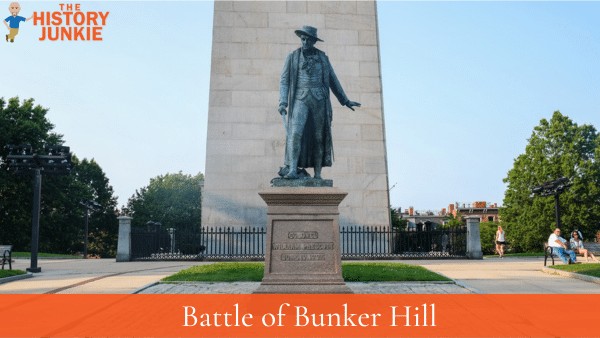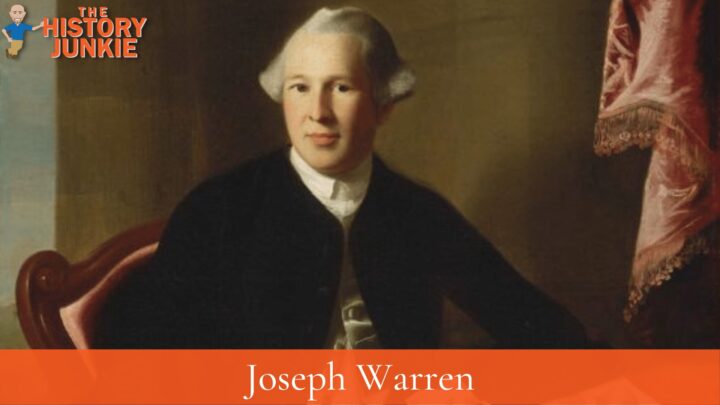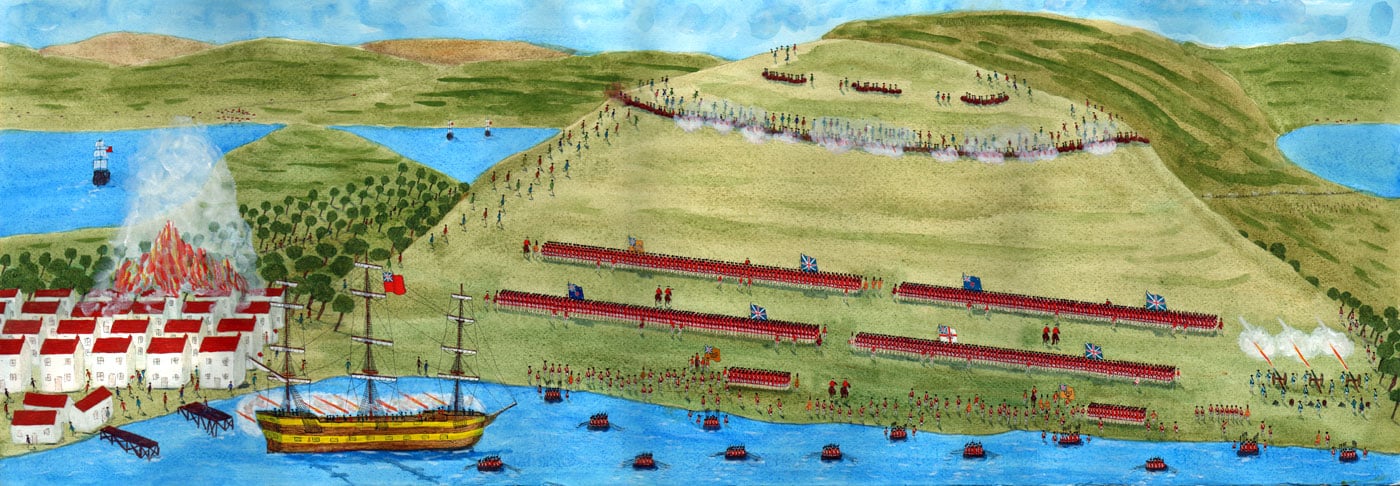The Battle of Bunker Hill took place on June 17, 1775, and was a costly victory for the British and became a great piece of propaganda for those pushing for the Declaration of Independence.

In the first battle of the American Revolution, two key players in the Battles of Lexington and Concord would fall, and the provincials would gain the respect of the British regulars.
It would become the bloodiest battle of the American Revolutionary War and would provide history with a symbol of early American resiliency.
New heroes from both sides would emerge from the fog that lifted after battles ended as would a renewed spirit for fighting.
Jump to:
The Events Leading Up To Bunker Hill
Battles of Lexington and Concord: The Battles of Lexington and Concord had left Thomas Gage and his British Army pinned down inside Boston. The British underestimated the army that was created under their nose and the ability of the men who fought.
Also Read: Reasons Why The British Lost the Battles of Lexington and Concord
They were greatly outnumbered and unable to move. Gage sent for reinforcements, to which the King obliged. The Cerberus was sent to bring order to Boston.
Capture of Fort Ticonderoga: Official war had not been declared, and many viewed the problems in Boston as an isolated rebellion. Shortly after Lexington and Concord, Benedict Arnold raised an army and was given permission to capture Fort Ticonderoga.
Along the way, he met up with Ethan Allen and the Green Mountain Boys, who had the same idea. The Fort was captured without firing a shot. The British garrison had no idea of the events in Lexington and Concord.
The Creation of the Continental Army: John Adams led the debate for independence on the floor of the Second Continental Congress. He was met with much opposition, but as the offenses of Britain continued to mount, support continued to grow.
He made a surprise nomination of George Washington as the Commander-in-chief of a new Continental Army. All voted in favor, and Washington became the new Commander-in-Chief.
Fortification of Breed's Hill: After learning of the British intention to take the high ground in Boston, the provincials, under the command of William Prescott, made a daring move to move from Bunker Hill to Breed's Hill.
They made the move at night, dug trenches, and built redoubts. The risk worked, and the British assaulted the front.
Trench Warfare Before and After Bunker Hill
18th Century Warfare consisted of two standing armies in the middle of a field, firing volley after volley until one of the lines broke.
The tactics were much more advanced than the description I am giving here, but this gives a general overview. The tactics were a product of the weapons of that day. Trench warfare was rare.
The technique at the Battle of Bunker Hill was not new but was rare in 18th-century warfare. The provincials took the high ground, dug trenches, and built redoubts to fire behind. This would prove effective and deadly against the British.
The British marched in a similar formation as they would have marched in an open-field battle, but their volleys were ineffective since the provincials were in trenches or tucked behind a redoubt.
Conversely, the provincials waited until the British were close and delivered crushing volleys that drove the British back down the hill.
This marked one of the first times that trench warfare was used in American warfare. Washington used it sparingly throughout the war but generally did not like it since he believed it trapped his men. During the War of 1812 and the Mexican-American War, trench warfare was rare.
It would not be until the Civil War that trench warfare was used consistently and effectively. Its use at the Siege of Petersburg changed the way war was fought and ushered in a new age of warfare.
World War I would be fought in the trenches. The European powers built large trench systems that caused stalemates throughout the theatre of war. Men would live and travel in trenches.
By the time of World War II, trench warfare became obsolete and was replaced with foxholes. The mobilization of weapons had caught up with the technology, and men could now rush a trench without taking heavy casualties.
The foxhole remained the standard until the Vietnam War, when it was replaced with bunkers.
Fortification of Breed's Hill
General Henry Clinton was on reconnaissance duty that night and heard the provincials working on Breed's Hill. He reported the situation to General Thomas Gage and General William Howe; however, neither found it necessary to prepare for battle.
This blunder allowed William Prescott and the other commanding officers to efficiently fortify Breed's Hill and to also build a redoubt that would protect their flanks.
Around 4:00 AM, a sentry reported to the HMS Lively, and the Lively opened fire. The cannon blast awoke Admiral Samuel Graves, who was aboard the flagship HMS Somerset and ordered the firing to end.
General Thomas Gage, once he saw the situation, ordered all 128 guns to fire on the provincial's position. They did, but had little effect.
The sun revealed a flaw in Prescott's fortification. He realized that his position could be easily flanked. Due to time constraints, Prescott opted to build a breastwork that would protect his flanks.
If Howe had moved his men quicker, Prescott would not have been able to complete such a task, but he did not act quickly enough, and Prescott's plan would lead to a British slaughter at the Battle of Bunker Hill.
British Preparations
After seeing the colonial preparations on Breed's Hill, General Henry Clinton suggested that the British attack from Charlestown Neck would cut off any retreat that the provincials could attempt.
After considering the plan, General Howe opted to attack the hill directly. He did not believe that the colonists could defend the hill.
The British began to organize their assault force, and the process took six hours. This allowed the provincials to build the breastwork to protect their flank and to bring up reinforcements.
While assembling, Howe noticed that the provincials had begun to reinforce, so he sent word to General Thomas Gage for more troops. This wait allowed William Prescott to also send for reinforcements, thus making the Battle of Bunker Hill that much more difficult for the British.
Among Howe's officers were Major John Pitcairn, who had seen action at the Battles of Lexington and Concord, and Brigadier General Robert Pigot, who would lead a direct assault on the redoubt.
Joseph Warren Reinforcements
After the British came ashore, they ate lunch and awaited reinforcements, thus exposing their plans to William Prescott.
Prescott then ordered reinforcements, and among the reinforcements were Joseph Warren and Seth Pomeroy.

Both of these men were well-known Massachusetts men and militia leaders. However, on this day, they served as citizens.
Although the provincials held high ground and had a secure position, there was still chaos at Bunker Hill. Americans have always been independent-minded, and this day is no different.
Also Read: 25 Massachusetts Bay Facts and Timeline
Many blatantly disobeyed orders from superior officers, some reinforcements stopped at Bunker Hill and then went back home, and others fled at the sight of the first casualty. It was a chaotic scene.
The Attack on Breed's Hill

Around 3 PM, the British were ready to assault the fortifications on Breed's Hill. Brigadier General Pigot was already taking casualties from sniper fire. Howe then ordered Admiral Graves to remove the snipers.
Graves fired a shot into the town and then proceeded to send a landing party down to set the town on fire. It did not have much effect as Pigot still took casualties from snipers. These snipers disrupted their feint on the redoubt.
General Howe ordered the assault on the left flank of the provincials. The devastating fire on both sides surprised him, and the British took heavy casualties.
The provincials used the height and stone fences to hide and steady their muskets. This resulted in Howe's light infantry and grenadiers retreating.
The regulars reformed and began their assault on Breed's Hill. This time, Pigot would not feint an attack, but instead, he would assault the redoubt even without the support of General Howe's men.
Howe also changed course and marched on the position near the rail fence. The British once again met fierce gunfire and took heavy casualties.
In this assault, many of the British companies lost ¾ - ⅞ths of their men. Howe retreated and waited for reinforcements for his third assault.
It was during the third assault that the British were able to break through the redoubt. Even so, the provincials poured musket balls down on them, and the British took heavy casualties once again.
Major John Pitcairn was lost during this assault, as were many British officers. Once the British were able to break through the redoubt and fight in hand-to-hand combat, they gained an advantage.
The British muskets were fitted with bayonets, while the American muskets were not. William Prescott fought bravely but eventually retreated. It was during the retreat that Dr. Joseph Warren, the hero of Paul Reveres Ride, fell.
General John Burgoyne spoke favorably of the American retreat at the Battle of Bunker Hill and complemented its quickness and organization. It was during the retreat on Bunker Hill that most of the provincials were killed.
The provincial militia had inflicted heavy damage on the British regulars, and although the British had taken the ground, the morale of the American army was never higher.

Fallout
The American losses at the Battle of Bunker Hill totaled about 450 men. 140 of the men were killed, 30 men were captured, and many would die in prison camps.
The British lost 1,054 men. It was the highest amount of casualties ever lost by the British in one battle. Among the losses were around 100 commissioned officers, which was a significant number of the British officer corps in North America.
The Battle of Bunker Hill was both good and bad for the provincials. It was good that the Americans had humbled the British.
The ragtag farmers had fought bravely and, due to British arrogance, had killed over 1,000 British men.
It was a significant boost to morale, and even though the British had taken the land, they were unable to halt the Siege of Boston.
The negative effects were the false sense of hope. Americans erroneously believed that they could defeat the British in their current form. The Battle of Bunker Hill had given them misguided confidence.
When George Washington took command of the militia in Boston, he quickly saw how depraved the men were.
The Battle of Bunker Hill also brought the realization to the British that it was going to take a full-scale war to squash the rebellion. Boston, although it had been a disaster up to this point, was not tactically important.
New York was much more important. The British would eventually leave Boston and would return, but this time, the Americans would not win.
